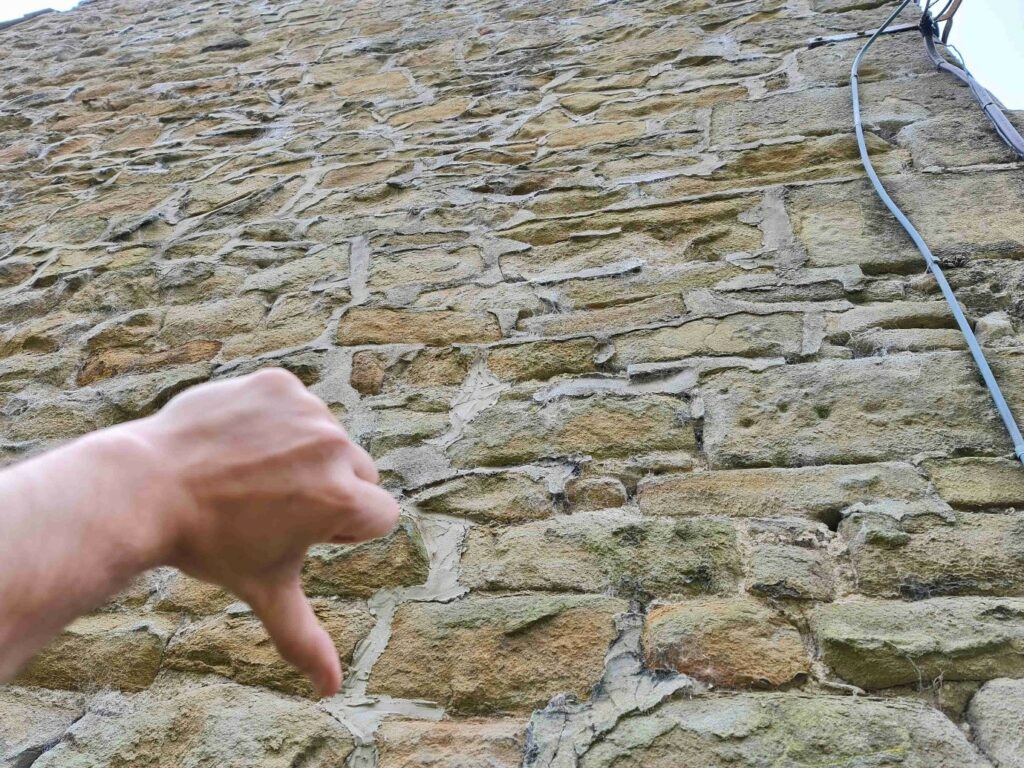Having started my work career as a builder it gave me a knowledgeable insight when working with different building materials. Being a bricklayer meant that I had to deal with most aspects within a building’s construction. The most interesting was people’s understanding of mortar, the average person has no idea the implications of having the wrong mortar applied to a property. When in fact it can be quite damaging to a property and cause defects to other elements of the building, the most common being dampness.
Covering the Manchester and Yorkshire areas means I get to see a lot of stone built properties, which are normally older than most. One of the major causes of damp in old houses is linked to the use of cement strap pointing. This became popular in the late 1960s and 1970’s when every builder was going around offering to ‘repoint your walls and make them look nice’. A solid brick or stone wall, built with lime mortar, needs to breathe. It loses its moisture content through the mortar joints. If this breathability is blocked, through the use of cement, the wall immediately starts to get wet. Water is trapped, and the only way it can get out is via brick or stone. In winter, the damp brickwork then freezes, and the familiar rotting and spalling bricks or stone start to appear. Cement pointing is responsible for dreadful damage to thousands of walls all over the country. At the same time as trapping water, it forces water into the wall, where it emerges inside, blowing plasterwork, and creating the usual symptoms of ‘rising damp’ which of course, it is not. Builders rarely if ever re-point properly, and the strap pointing usually falls off quite easily. Underneath, you will find nice, solid lime mortar that isn’t damaged. If the mortar is very badly eroded or has cracks and holes in it, then you may want to re-point using hydraulic lime mortar.
Repointing of old walls must be done using a mortar that is softer than the material we are pointing, this gives the wall the best chance of breathing. Generally, a crumbly sandstone or soft limestone would need what we call an NHL 2.5 hydraulic lime mortar to point it with. The joints are raked out to a depth that is equivalent to twice the width of the mortar joint. It’s important to make sure that we have a good depth of mortar in the joint.

But how do we tell the difference between cement and lime based mortar? The first thing to look for is the colour of the mortar is it closer to a shade of grey or a shade of white? A whiter mortar typically indicates a lime mortar. If mortar is greyer in colour, it is likely Portland cement modern mortar. Lime hardens much more slowly than cement-containing mortars, making it much more workable. Lime is also less brittle and less prone to cracking, and any cracked areas can absorb carbon dioxide and mend over time. Cement hardens very quickly, but may be too strong for some applications, e.g., working with old bricks. Cement is also prone to cracking as a structure settles, and may eventually require repair.
Personally I prefer the touch test as a way to determine, because Lime is crumbly, most of the time you can run your finger along the joint and fragments will come off, whereas with cement they will not. Lime will also react with white vinegar and fizz on contact, just in case you wanted a third option.



